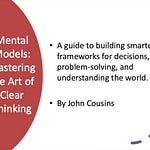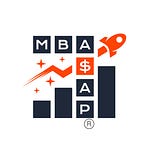Mental Models and Heuristics: Shortcuts in Decision-Making
"The mind is not a vessel to be filled but a fire to be kindled." — Plutarch
THE RELATIONSHIP BETWEEN MENTAL MODELS AND HEURISTICS
Mental models and heuristics are both tools our minds use to navigate complexity, but they serve different functions in our cognitive toolkit. Understanding their relationship—how they work together, where they differ, and their respective strengths and limitations—is essential for clear thinking.
Defining the Relationship
Mental models are frameworks that represent how something works in the real world. They are structured representations of systems, concepts, or domains that help us understand, explain, and interact with our environment. Think of mental models as maps of reality that guide our reasoning and decision-making.
Heuristics, on the other hand, are mental shortcuts or rules of thumb that allow us to make quick decisions without having to analyze every detail of a situation. They are cognitive strategies that simplify complex problems, enabling faster—though not always optimal—solutions.
The relationship between the two is complementary:
• Mental models provide the structure for understanding the world—they represent how systems work and how variables interact.
• Heuristics provide the speed for navigating that world—they allow us to move quickly through decisions without getting bogged down in analysis.
Consider an investor evaluating a company. Their mental model might include understanding how businesses create value, how industries evolve, and how markets function. Their heuristics might include shortcuts like "avoid companies with high debt-to-equity ratios" or "be wary of businesses where management keeps changing." The mental models frame their understanding, while the heuristics allow them to filter opportunities efficiently.
From Models to Shortcuts
Heuristics often develop as simplified versions of more complex mental models. As we gain experience in a domain, we begin to recognize patterns and develop rules of thumb that encapsulate that knowledge in a more accessible form. This evolution follows a typical pattern:
1 We learn a comprehensive mental model (e.g., understanding all factors that affect stock prices)
2 Through experience, we identify reliable patterns
3 We develop heuristics that codify these patterns (e.g., "be fearful when others are greedy, and greedy when others are fearful")
4 These heuristics allow faster decision-making without revisiting the full mental model each time
This process enables cognitive efficiency but introduces the risk of oversimplification. A heuristic that works in most cases may fail spectacularly in others if it omits critical variables from the underlying mental model.
THE NATURE OF HEURISTICS
Heuristics are not merely simplified mental models—they are distinct cognitive tools with their own characteristics, purposes, and limitations. Understanding their nature helps us use them more effectively and recognize when they might lead us astray.
Types of Heuristics
Psychologists have identified several categories of heuristics that humans commonly employ:
1 Availability Heuristic: We judge the likelihood of events based on how easily examples come to mind. If you can readily recall plane crashes from news stories, you might overestimate their probability compared to car accidents, even though the latter are far more common.
2 Representativeness Heuristic: We assess the probability that something belongs to a particular category based on how similar it is to our prototype of that category. For instance, if someone is described as shy and bookish, we might assume they're more likely to be a librarian than a salesperson, even if there are far more salespeople in the population.
3 Anchoring Heuristic: We rely heavily on the first piece of information we receive (the "anchor") when making decisions. In negotiations, the first number mentioned often exerts a powerful influence on the final outcome.
4 Affect Heuristic: We make judgments based on our emotional reactions. If thinking about nuclear power evokes negative emotions, we're more likely to perceive it as risky, regardless of statistical evidence.
5 Recognition Heuristic: We assume that if we recognize one option but not others, the recognized option is superior. This explains why companies invest in brand awareness—a recognized brand often gets chosen over unknown alternatives.
These heuristics operate beneath our conscious awareness much of the time, shaping our judgments and decisions without our explicit knowledge. By understanding them, we can better identify when they're influencing our thinking.
How Heuristics Form
Heuristics develop through several processes:
1 Direct Experience: As we encounter similar situations repeatedly, we develop rules of thumb based on what typically works.
2 Cultural Transmission: We absorb heuristics from our social environment—maxims, proverbs, and conventional wisdom often encode heuristic knowledge.
3 Evolutionary Adaptation: Some heuristics may be hardwired into our cognitive architecture, having provided survival advantages to our ancestors.
4 Deliberate Creation: We can consciously design heuristics to simplify decision processes, like creating personal rules for financial decisions.
The formation of heuristics reflects our mind's continual effort to balance accuracy with efficiency. In a world of information overload, heuristics provide necessary cognitive compression.
THE ADVANTAGES OF HEURISTICS
Heuristics offer significant benefits that help explain their prevalence in human reasoning. Understanding these advantages helps us appreciate why heuristics persist despite their potential for error.
Cognitive Efficiency
In a world of overwhelming complexity, heuristics serve as essential cognitive tools:
1 Processing Speed: Heuristics dramatically reduce the time and mental effort required for decisions. While a complete analysis might take hours or days, a well-calibrated heuristic can yield a good enough answer in seconds.
2 Reduced Cognitive Load: By simplifying variables and relationships, heuristics free up mental bandwidth for other tasks. This is particularly valuable in high-pressure situations where cognitive resources are limited.
3 Decision Momentum: Heuristics prevent analysis paralysis, allowing us to maintain forward progress rather than getting stuck in endless deliberation.
The poker player Annie Duke illustrates this well:
"In poker, you have to make the best decision you can with the information you have, often in just a few seconds. Good players develop heuristics that simplify complex probability calculations—not because they're mathematically perfect, but because they're good enough to keep playing while your opponents get stuck calculating."
Practical Effectiveness
Despite their simplicity, heuristics often perform remarkably well:
1 Ecological Rationality: Heuristics can be surprisingly accurate when matched to the right environment. Gerd Gigerenzer's research shows that simple heuristics often outperform complex algorithms in uncertain, dynamic environments where the "rules of the game" are constantly changing.
2 Exploiting Environmental Regularities: Effective heuristics leverage stable patterns in our environment. The recognition heuristic works because recognition often correlates with quality or prevalence in many domains.
3 Robustness to Noise: By ignoring most variables and focusing on a few key factors, heuristics can be less susceptible to random fluctuations or "noise" in data that might throw off more complex approaches.
In many real-world scenarios, the theoretically optimal solution (which might require analyzing dozens of variables) delivers only marginally better results than a well-chosen heuristic that focuses on the most predictive factors.
Accessibility and Communication
Heuristics offer social and practical advantages that more complex models often lack:
1 Ease of Teaching and Learning: Simple rules of thumb can be quickly taught, remembered, and applied, making them ideal for transferring knowledge.
2 Common Language: Heuristics provide shared decision frameworks that facilitate coordination within teams and organizations.
3 Implementation Consistency: The simplicity of heuristics makes them more likely to be applied consistently across different situations and by different people.
The investment world offers numerous examples, from Peter Lynch's "invest in what you know" to Warren Buffett's "be fearful when others are greedy." These heuristics encapsulate sophisticated investment philosophies in memorable, applicable forms that investors can actually implement.
THE LIMITATIONS AND PITFALLS OF HEURISTICS
While heuristics offer valuable cognitive shortcuts, they also introduce systematic biases and errors into our thinking. Understanding these limitations is crucial for knowing when to rely on heuristics and when to engage in more deliberative reasoning.
Cognitive Biases
Heuristics can generate predictable errors in judgment:
1 Overconfidence: Quick, intuitive judgments often come with unwarranted certainty. We tend to overestimate both the accuracy of our heuristic judgments and our ability to predict outcomes.
2 Neglect of Base Rates: Heuristic thinking frequently ignores statistical fundamentals. For example, when judging someone based on a personality description, we often neglect the base rate frequency of different professions (see Bayes' Theorem).
3 Insensitivity to Sample Size: We tend to draw strong conclusions from small samples, ignoring the principle that larger samples provide more reliable information.
4 Conjunction Fallacy: Heuristic reasoning sometimes leads us to judge specific scenarios as more likely than general ones, violating basic probability laws. When Amos Tversky and Daniel Kahneman presented people with a description of "Linda" as socially conscious and outspoken, participants rated "Linda is a bank teller and active in the feminist movement" as more probable than "Linda is a bank teller"—a logical impossibility.
These biases reflect the trade-offs inherent in heuristic thinking: by prioritizing efficiency over accuracy, we introduce systematic errors into our judgments.
Context Blindness
Perhaps the greatest danger of heuristics lies in their inappropriate application:
1 Domain Mismatches: Heuristics developed in one context often get misapplied to situations where they don't work. For instance, heuristics that work well in stable environments may fail spectacularly in rapidly changing ones.
2 Failure to Adapt: We tend to apply familiar heuristics even when conditions change, leading to declining performance over time. The history of business is littered with once-successful companies that failed to update their heuristics as markets evolved.
3 One-Size-Fits-All Thinking: We often fall into the trap of treating our favorite heuristics as universally applicable rather than recognizing their domain-specific utility.
Ray Dalio of Bridgewater Associates observed this phenomenon in investing:
"The biggest mistake investors make is to believe that what happened in the recent past is likely to persist. They assume that something that was a good investment in the recent past is still a good investment. Typically, high past returns simply imply that an asset has become more expensive and is a poorer, not better, investment."
Ethical Hazards
Some heuristics pose ethical problems:
1 Stereotyping: Many social heuristics amount to stereotyping, where we make judgments about individuals based on perceived group characteristics. Even when statistically accurate at a group level, applying such heuristics to individuals can be both inaccurate and harmful.
2 Status Quo Bias: Heuristics often favor the familiar and existing, creating resistance to beneficial changes or innovations.
3 Empathy Gaps: Emotional heuristics can lead us to dismiss or devalue the experiences of those unlike ourselves, as their reactions don't match our intuitive expectations.
In professional contexts, unchecked heuristic thinking can lead to discrimination in hiring, investment, lending, and other consequential decisions, often without decision-makers being conscious of these biases.
BALANCING MODELS AND HEURISTICS: A PRACTICAL APPROACH
The challenge isn't choosing between mental models and heuristics but knowing when and how to use each approach. Strategic cognitive flexibility—switching between quick heuristic judgments and more deliberative model-based reasoning—characterizes effective thinkers.
When to Trust Heuristics
Heuristics perform best under specific conditions:
1 High Validity Environments: Settings where clear, reliable feedback exists and patterns remain consistent over time. Chess, firefighting, and certain medical diagnoses feature strong environmental regularities that expert heuristics can exploit.
2 Time Constraints: When decisions must be made quickly, well-developed heuristics often outperform rushed analytical approaches.
3 Cognitive Overload: In situations involving overwhelming information, heuristics help us focus on the most relevant factors.
4 Incremental Decisions: For low-stakes decisions that will be repeated many times, heuristics provide efficiency without undue risk.
Expert intuition—which often operates through sophisticated heuristics—develops most reliably in these high-validity environments. As psychologist Gary Klein has documented, experienced firefighters, nurses, and chess grandmasters make remarkably accurate split-second decisions using pattern recognition heuristics refined through thousands of hours of practice.
When to Favor Models
More deliberative, model-based thinking becomes essential in other contexts:
1 Novel Situations: When facing unprecedented challenges, mental models help us reason from first principles rather than relying on potentially irrelevant heuristics.
2 High-Stakes Decisions: One-time, consequential decisions warrant the extra time and effort of thorough analysis.
3 Low Validity Environments: In domains with poor feedback, inconsistent patterns, or high unpredictability (like stock picking or political forecasting), heuristics often perform poorly.
4 Debiasing Efforts: When addressing sensitive issues where biases could lead to harmful outcomes, structured analysis using explicit models helps counteract implicit biases.
Daniel Kahneman recommends a disciplined approach in these scenarios:
"Whenever there are significant consequences, slow down and create a structured process. Force yourself to check facts and articulate assumptions explicitly."
Creating a Learning Loop
The ideal approach integrates heuristics and models in a continuous improvement cycle:
1 Start with Models: Build fundamental understanding through comprehensive mental models of the domains that matter to you.
2 Develop Heuristics: As you gain experience, identify reliable patterns that can be codified into time-saving heuristics.
3 Apply with Awareness: Use heuristics for day-to-day decisions, but maintain awareness of when they're being applied.
4 Monitor Outcomes: Track the results of your heuristic-based decisions, paying particular attention to unexpected outcomes.
5 Update and Refine: Use this feedback to revise both your mental models and the heuristics derived from them.
This cycle allows you to operate efficiently while continually improving the quality of your decisions. The most sophisticated thinkers develop what psychologist Robin Hogarth calls "deliberate intuition"—they know when to trust their heuristic judgments and when to override them with more systematic analysis.
DEVELOPING BETTER HEURISTICS
Not all heuristics are created equal. By understanding what makes heuristics effective, we can develop better ones and refine those we already use.
Characteristics of Effective Heuristics
The best heuristics share several features:
1 Simplicity: Truly useful heuristics are easy to remember and apply. Complex decision rules defeat the purpose of having shortcuts.
2 Specificity: Good heuristics are tailored to particular domains rather than being overly general. "Always diversify investments" is more useful than "don't put all eggs in one basket."
3 Clear Triggers: Effective heuristics include clear conditions for when they should be applied. "If X, then Y" formulations help prevent inappropriate application.
4 Empirical Grounding: The most reliable heuristics emerge from real-world experience and data rather than pure theory.
5 Built-in Limitations: The best heuristics acknowledge their own boundaries. "This works except when..."
Investor Howard Marks offers an example with his heuristic for market cycles:
"When investors are exuberant and paying high prices for assets while ignoring risk, I get defensive. When investors are depressed and selling cheap assets while obsessing about risk, I turn aggressive."
This heuristic is simple yet specific, with clear triggers and an implicit understanding of market psychology.
Methods for Creating Better Heuristics
To develop more effective heuristics:
1 Extract From Experience: Review your past successes and failures to identify patterns that can inform rules of thumb. What factors consistently led to good outcomes?
2 Borrow From Experts: Study the heuristics used by recognized experts in your field. These condensed insights often represent decades of trial and error.
3 Test Before Trusting: Before relying on a heuristic for important decisions, test it against historical cases or in low-stakes situations.
4 Refine Through Feedback: Systematically track the results of decisions made using your heuristics and adjust accordingly.
5 Consider Counterfactuals: For any heuristic, ask, "Under what conditions would this rule lead me astray?" This helps define appropriate boundaries.
The goal isn't to eliminate heuristics—they're essential cognitive tools—but to develop ones that accurately reflect the environments you operate in while being mindful of their limitations.
THINKING CLEARLY WITH MODELS AND HEURISTICS
Mental models and heuristics represent complementary aspects of effective thinking. Mental models provide depth and accuracy, while heuristics offer speed and accessibility. Neither is inherently superior; both serve vital cognitive functions.
The wisest approach involves developing a rich repertoire of mental models while cultivating awareness of the heuristics you use. This cognitive flexibility—knowing when to rely on quick intuitive judgments and when to engage in deeper analysis—characterizes the most effective thinkers.
As you build your mental toolkit, remember:
1 Models First, Heuristics Second: Develop deep understanding before creating shortcuts.
2 Match Tools to Tasks: Use heuristics for routine decisions and familiar patterns; employ mental models for novel, complex, or high-stakes situations.
3 Maintain Self-Awareness: Recognize when you're using heuristics and be alert to signs they might be inappropriate for the current context.
4 Embrace Continuous Learning: Let failures of both heuristics and models guide refinement of your thinking.
In the words of psychologist Amos Tversky,
"The dream of reason was not to rule out intuition, but to explain when you should and shouldn't trust it."
By understanding the relationship between your mental models and heuristics, you gain precisely this kind of metacognitive insight—knowing not just what you think, but how you think, and when to think differently.
With practice, you'll develop what Nobel laureate Daniel Kahneman calls "disciplined intuition"—heuristic thinking informed by rigorous models, combining the best of both approaches to navigate an increasingly complex world with clarity and confidence.
Jason Zweig of The Wall Street Journal says there are three ways to be a professional writer:
1. Lie to people who want to be lied to, and you’ll get rich.
2. Tell the truth to those who want the truth, and you’ll make a living.
3. Tell the truth to those who want to be lied to, and you’ll go broke.
I’m shootin’ for #2.

















Share this post